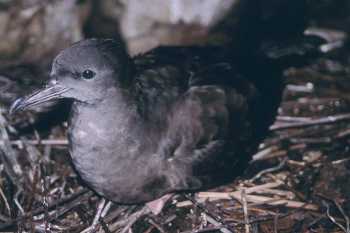The Wedge-tailed Shearwater Puffinus pacificus, along with eight other shearwaters of the genera Puffinus and Calonectris, has been identified as a potential candidate for listing within the Agreement (Cooper & Baker 2008, Cooper 2010).
The species has a wide distribution in the tropical Pacific and Indian Oceans and a large population, estimated as over five million birds (Brooke 2004). The Wedge-tailed Shearwater has been exploited for food by humans and is vulnerable at its breeding sites to introduced rodents, pigs and cats (Taylor 2000). Reduction of tuna populations by fishing may also be contributing to a decline as the bird forages in association with tuna schools.

Selected recent publications on Wedge-tailed Shearwaters
Baduini, C. L. 2002. Parental provisioning patterns of Wedge-tailed Shearwaters and their relation to chick body condition. Condor 104: 823-831.
Bancroft, W.J. 2008. Nearest neighbour analysis and spatial relationships of Wedge-tailed Shearwater, Puffinus pacificus, (Aves: Procellariiformes) burrow entrances at Radar Reef, Rottnest Island, Western Australia. Papers and Proceedings of the Royal Society of Tasmania 142: 31-34.
Bancroft, W.J. 2009. Research and recreational disturbance of Wedge-tailed Shearwater burrows on Rottnest Island, Western Australia: Managing human traffic in burrowing seabird colonies. Ecological Management & Restoration 10: 64-71.
Bancroft, W.J., Garkaklis, M.J. & Roberts, J.D. 2004. Continued expansion of the Wedge-tailed Shearwater, Puffinus pacificus, nesting colonies on Rottnest Island, Western Australia. Emu Austral Ecology 104: 79-82.
Bancroft, W.J., Garkaklis, M.J. & Roberts, J.D. 2005. Burrow building in seabird colonies: a soil forming process in island ecosystems. Pedobiologia 49: 149-165.
Bancroft, W.J., Hill, D. & Roberts, J.D. 2004. A new method for calculating volume of excavated burrows: the geomorphic impact of Wedge-tailed Shearwater burrows on Rottnest Island. Functional Ecology 18: 752-759.
Bancroft, W.J., Roberts, J.D. & Garkaklis, M.J. 2005. Burrowing seabirds drive decreased diversity and structural complexity, and increased productivity in insular-vegetation communities. Australian Journal of Botany 53: 231-241.
Bancroft, W.J., Roberts, J.D. & Garkaklis, M.J. 2005. Burrow entrance attrition rate in Wedge-tailed Shearwater Puffinus pacificus colonies on Rottnest Island, Western Australia. Marine Ornithology 33: 23-26.
Bancroft, W.J., Roberts, J.D. & Garkalis, M.J. 2008. Vertebrate fauna associates of the Wedge-tailed Shearwater, Puffinus pacificus, colonies of Rottnest Island: influence of an ecosystem engineer. Papers and Proceedings of the Royal Society of Tasmania 142: 21-30.
Brooke, M. [de L.] 2004. Albatrosses and Petrels across the World. Oxford: Oxford University Press.
Burger, A.E. 2001. Diving depths of shearwaters. Auk 118: 755-759.
Burger, A.E. & Lawrence, A.D. 2001. Census of Wedge-tailed Shearwaters Puffinus pacificus and Audubon's Shearwaters P. lherminieri on Cousin Island, Seychelles using call-playback. Marine Ornithology 29: 57-64.
Congdon, B.C., Krockenberger, A.K. & Smithers, B.V. 2005. Dual foraging strategy in a tropical procellariid, the Wedge-tailed Shearwater. Marine Ecology Progress Series 301: 293-301.
Cooper, J. 2010. A brief review of the conservation status of shearwaters Calonectris and Puffinus. ACAP AC5 Inf 15.
Cooper, J. & Baker, G.B. 2008. Identifying candidate species for inclusion within the Agreement on the Conservation of Albatrosses and Petrels. Marine Ornithology 36: 1-8.
Dyer, P.K. 2000. Wedge-tailed Shearwaters on Mudjimba Island, Queensland: numbers and breeding success. Corella 24: 15-18.
Dyer, P. K. 2001. Burrow occupancy by Wedge-tailed Shearwaters and Flesh-footed Shearwaters on Lord Howe Island. Corella 26: 38-40.
Dyer, P.K. 2003. A decline in the number of Wedge-tailed Shearwaters breeding on Raine Island. Corella 27: 13-17.
Peck, D.R. & Congdon, B.C. 2005. Colony-specific foraging behaviour and co-ordinated divergence of chick development in the Wedge-tailed Shearwater Puffinus pacificus. Marine Ecology Progress Series 299: 289-296.
Peck, D.R. & Congdon, B.C. 2006. Sex-specific chick provisioning and diving behaviour in the Wedge-tailed Shearwater. Journal of Avian Biology 37: 1-7.
Peck, D.R., Bancroft, W.J. & Congdon, B.C. 2008. Morphological and molecular variation within an ocean basin in Wedge-tailed Shearwaters (Puffinus pacificus). Marine Biology 153: 1113-1125.
Peck, D.R., Smithers, B.V., Krockenberger, A. & Congdon, B.C. 2004. Sea surface temperature constrains Wedge-tailed Shearwater foraging success within breeding seasons. Marine Ecology Progress Series 281: 259-266.
Smithers, B.V., Peck, D.R., Krockenberger, A.K. & Congdon, B.C. 2003. Elevated sea surface temperature and reproductive failure of Wedge-tailed Shearwaters (Puffinus pacificus) in the Southern Great Barrier Reef, Australia. Marine & Freshwater Research 54: 973-977.
Taylor, G.A. 2000. Action Plan for Seabird Conservation in New Zealand. Part B: Non-threatened Seabirds. Threatened Species Occasional Publication No. 17: 236-435.
With thanks to Wesley Bancroft and Allan Burger.
John Cooper, ACAP Information Officer, 21 November 2010

 English
English  Français
Français  Español
Español